Thanks to Facebook, the concept of social media took off. It continues to remain the first and only social media account for millions of people across the planet. Statistics reveal that Facebook has nearly 3 billion active users—almost half the world's population! Despite so many social media platforms competing for attention today, most people prefer Facebook to everything else.
Every brand’s social media journey begins with a Facebook business page. The page lets you connect with Facebook’s entire member base and widen your Instagram reach, too.
However, just like you, millions of Facebook brands are competing for user attention. Getting the most from your Facebook presence requires strategy, consistent effort, and paid advertising.
In this article, we share all the tips and tricks you need for Facebook business page success. We cover everything from “how to add a business page on Facebook” to how and when to share posts, run ads, and more!
Is Facebook a good place to sell products and services?
Before we get started, let’s take a minute to consider if Facebook is really worth your energy and time. If you are an ecommerce seller, getting on Facebook is a no-brainer. 37% of Facebook users have purchased from the platform—that’s 1 billion paying customers! If that’s not enough, here are more reasons why all ecommerce sellers must have a Facebook page for business.
- With the right content, you can go viral on the platform. For example, Oreo’s recipe videos rack up millions of views within days of posting. Just one viral post can mean hundreds of thousands of dollars in sales overnight!
- Even if people don't purchase immediately, they can save your content and bookmark your page for later purchases. You gain brand awareness and loyalty for long-term success.
- Features like Facebook Shop, Meta Pixel, and Audience Insights make it easy for brands to connect with customers. You can do everything from retargeting to reaching new customers to really grow your brand!
- With a bit of training, you can harness the power of Facebook’s algorithms to reach buyers at the perfect time. For example, if you sell shoes, Facebook will show your shoe ads to customers looking for shoes on Google!
Actually, Facebook is a must for every business type. It's not just for large brands with global reach. If you operate locally, you can still target your intended audience by filtering for location. Even if you are a hyperlocal business like a cafe or salon, you still need a Facebook business page for better sales. You can use it to engage with Facebook groups in your local community and connect to the people who matter.
How to create a Facebook business page
Getting started on Facebook for business is easy. You will need a personal Facebook profile. Assuming you have that, do the following:
- From the Pages section, click Create New Page.
- Add your Page name and category.
- Enter your basic business information and click Create
- Add more details, such as contact, hours, and location, and click Next.
- Add profile and cover photos. Stick to brand logos where possible, and do not copy content from other businesses.
- Edit the action button. To get people to connect with you quickly, you can choose from Shop Now, Message, Whatsapp, Learn More, and similar action buttons. Click Next.
- Invite people you know to connect with your Page and get started.
- Click Done.
That’s it—You are all set. You can now create posts, share links, share posts from other pages, follow and like, leave comments, and chat with customers. You can also run ads and paid campaigns to get more followers.
Start your page by sharing content with your friends and personal community. You can also run low-cost campaigns to increase likes and followers for new pages.
Analyze Your Business and Audience
Now that your page is up, the next question is how you will use it. It's crucial to have a clear understanding of your business objectives. What are you aiming to achieve with your Facebook business page?
Set goals
At first, most new brands focus on brand awareness. Early goals typically aim for a percentage increase in followers and likes each month. Unfortunately, the way social media works, you must build credibility before selling anything. Credibility typically looks like more shares and comments on your existing content. You should also try to collect some reviews. Once your base is established, you can push for other goals, like driving sales and generating leads.
Analyze your audience
Knowing your audience is key to creating content that resonates with them. Start by identifying the demographic characteristics of your ideal customer, such as age, gender, location, and interests. Facebook's Insights tool offers valuable data about who interacts with your page and how. Use this information to refine your target audience and tailor your messaging to meet their needs and preferences.
Pay attention to audience activity in your posts. High engagement indicates content that resonates with your audience. Analyze what type of content performs best so you can produce more of what your audience loves.
Analyze your competition
Your customers are already visiting competitors' Facebook business pages. It's worth analyzing their Facebook activity to identify gaps in your strategy. Note what types of posts generate the most engagement, how they handle customer interactions, and any promotional strategy they employ. This can offer inspiration and help you differentiate your brand and stand out.
More Tips to Boost Your Facebook Business Page for Better Sales
Facebook success is, first and foremost, about building community. You can’t keep promoting products and discounts or talking about yourself. You must get customers to connect and engage with you beyond what you sell. This could be through causes, education, freebies, events, or solid customer service.
Facebook success requires planning and strategy. We share some tips to get started.
Plan Your Content
Content is the foundation for social media success. You must post consistently to always be front and center of your audience's minds. Even top brands post at least 2-3 times daily to stay relevant.
As a small business owner, it’s easy to drop the ball on social media and go weeks and months without posting anything. However, if you don't post for too long, Facebook keeps reducing customer reach. That means you must spend more on your next ad campaign to reach the same number of people.
Content quality at volume requires planning a content calendar in advance. Think about upcoming holidays and plan content around them. For example, the pet brand Chewy shares content about flea season as winter ends.
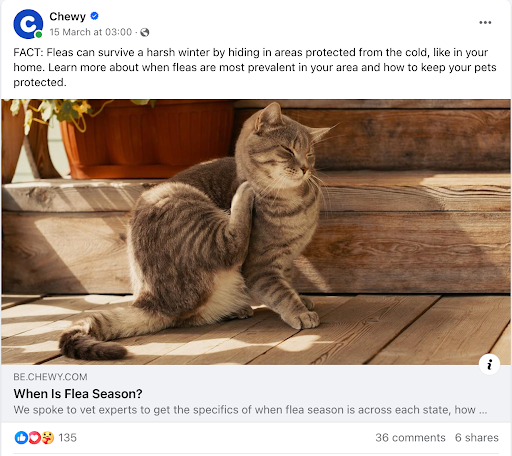
The content calendar will also help you plan promos, offers, and sales. For example, you can promote gift items for Valentine's Day, cleaning products around spring, and clearance sales near Christmas.
Mix up your content
There are different rules regarding content types and what you should post. You don't have to create unique or promotional content every time you post; you can follow different strategies.
5:3:2 Rule
Out of every ten posts you share on Facebook
- Five posts should be curated from other sources your audience is interested in.
- Three posts should be self-created or promotional content
- Two posts should be personal, fun content that humanizes your brand.

Allen Solly humanizes the brand with the “Every day is Friday” (or boring weekdays) theme, which many people relate to.
Rule of Thirds
The Rule of Thirds is another content strategy advocating for a balanced approach:
- One-third of your content promotes your business and drives conversions.
- One-third is content from other sources that provide value to your audience.
- One-third is dedicated to personal interaction with your audience to build relationships.
80/20 Rule
The 80/20 Rule, also known as the Pareto Principle, is applied in social media to suggest that:
- 80% of your content should inform, educate, or entertain your audience, providing value and building brand trust.
- 20% of your content can be directly about your brand, promoting your products or services.
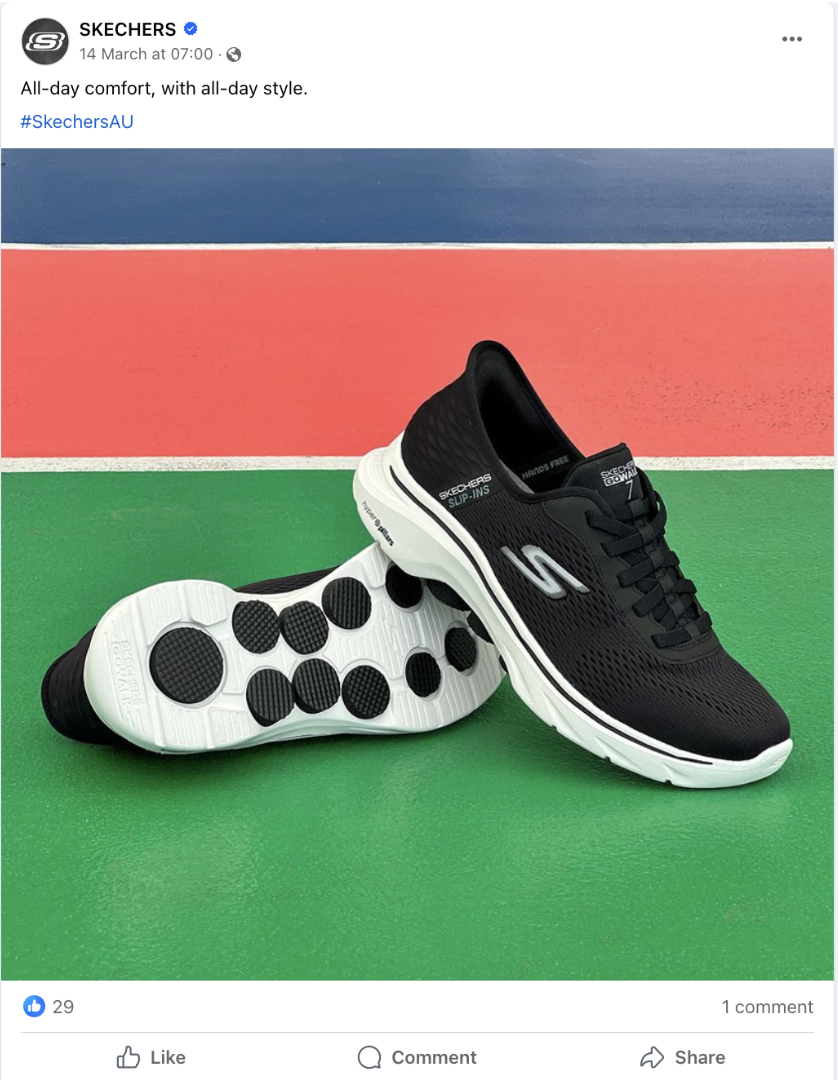
Sketchers showcase products using unique colors and product positioning.
Post Ideas
Based on the above rule, for the majority of time, you can post content like:
- Scientific research papers on educational topics related to your products
- Links to infographics, articles, blogs
- Funny memes and videos
- Behind-the-scenes, or employee stories
- Personal incidents and experiences
A small percentage of posts can be promotional content about your products.
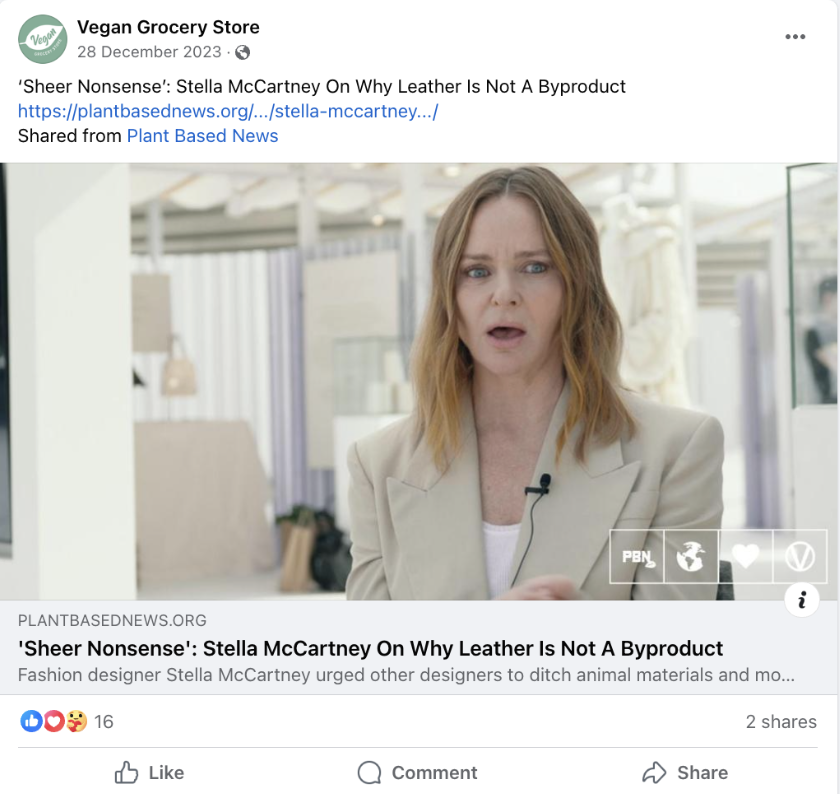
Vegan grocery store shares educational content of interest to its followers
Share Videos
Videos play an important role in most users' Facebook experience. Since videos have their own dedicated section, many members engage with the platform only through Videos. Short videos (called reels) show up automatically in the News Feed of customers who follow your business. You can also run Live sessions and talk to customers directly. You can see their comments and respond in real time. Customers can also find you easily under the Live Now Section of the platform.
Putting yourself on video can be scary initially but gets easier with practice. You can also do videos that don’t show your face. For example, video your hands as you use a product or do a slide show with voice-over.
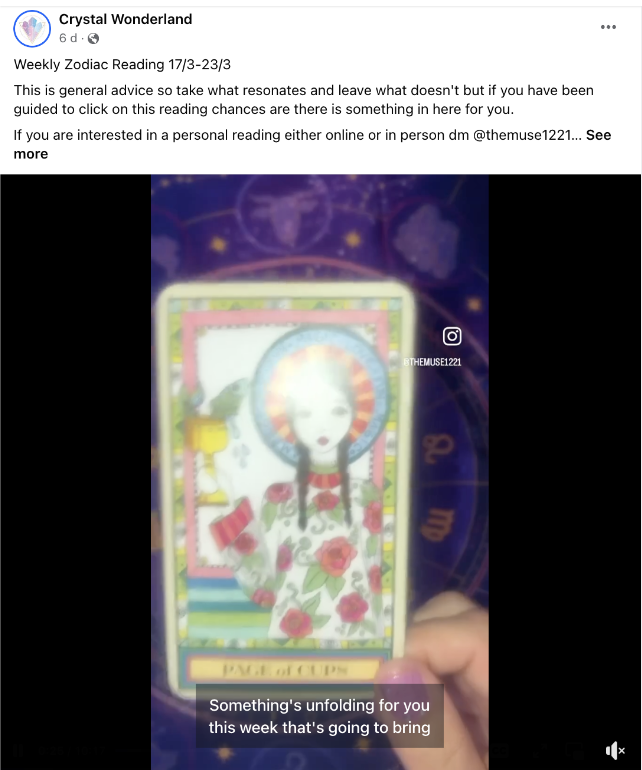
Crystal Wonderland shares a video about zodiac readings - a topic of interest for crystal buyers.
Create a Facebook Group
Creating a group associated with your brand is a great way to build community. Groups should NOT be “salesy: but should relate to specific challenges or interests of your buyers. For example, if you sell:
- Health foods—start a weight loss group
- Shoes—start a walkers group
- Kitchen items—start a recipe group
- Pet food—start a pet owners' group
Your group should encourage discussions, sharing, and asking and answering questions. You can promote relevant products by commenting in answers or occasionally in a specific thread. You will have to set up group rules and moderation for success. Initially, it may be hard—but if the group takes off, you can really build brand loyalty around your brand.
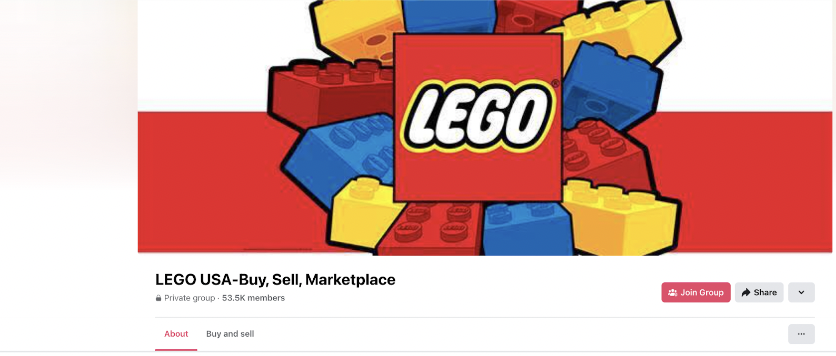
LEGO runs fan groups in every country for community building
Offer Exclusive Deals and Partnerships
To strengthen your Facebook community, consider offering exclusive deals and discounts to Your followers only. You could also run lucky draws and giveaways in exchange for shares and likes. Time these around holidays and other events related to your audience. You can also offer exclusive discount codes that people can use to shop from your website or Amazon store.
Facebook also gives you an opportunity to partner with related brands. For example, if you sell kids' toys, you can partner with a local play center and cross-promote each other's posts and products. Similarly, if you sell kitchen products, you can partner with food and grocery brands. Use the networking opportunity that Facebook provides to connect with key players in your sector.
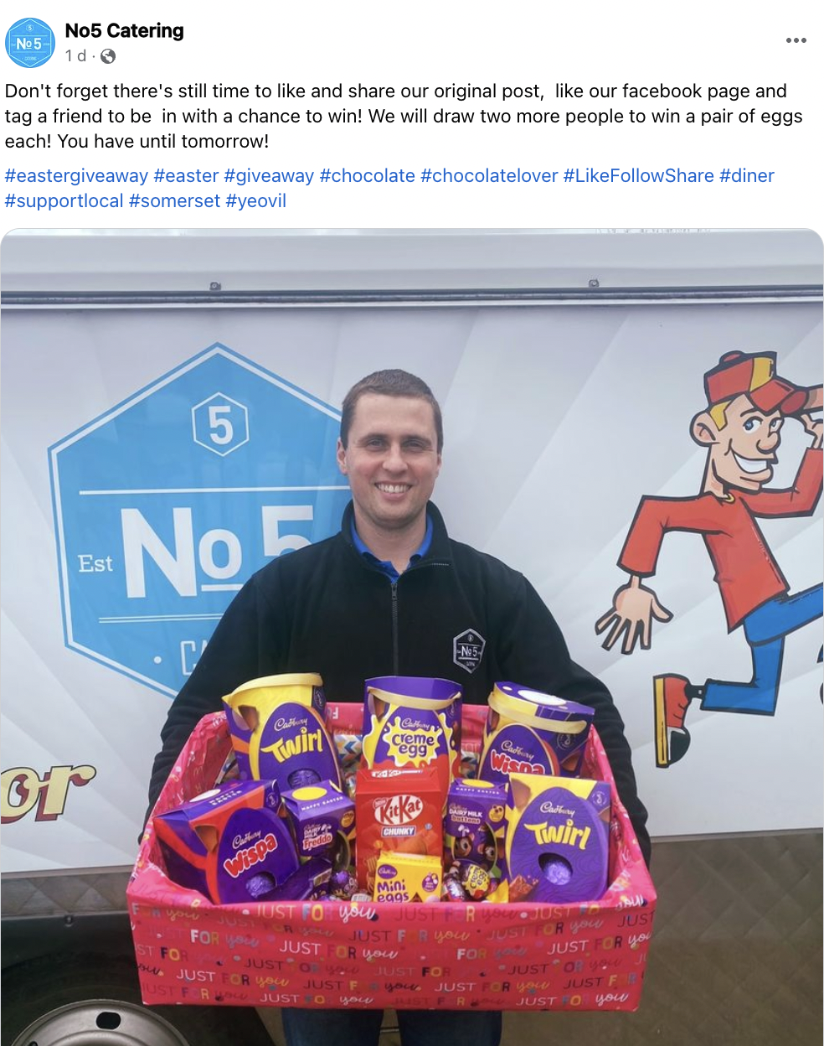
Run Events
Facebook Events has a dedicated section, and many users actively look for free and paid events and things to do on Facebook. Creating and hosting events gives you access to a brand-new audience base with minimal expenditure.
If you are just starting, consider participating in industry events organized by others. You could sponsor a stall or give a talk and invite your Facebook followers to attend. As you grow, you can host your own events and talks that are of interest to your audience.
There is also an opportunity to run live online events and forums, where you can offer free learning opportunities to your audience and an option to purchase from you at the end of the event.

Provide Customer Service
It is critical that you efficiently engage with customers on the platform. Facebook rewards business owners who actively reply to customer comments, like, and share their posts. The most crucial thing is to respond promptly when they chat with you via Facebook Messenger. If you reply to 90% of customers within 15 minutes, you get the green “Very responsive” badge on your page. The badge encourages more customers to contact you and buy from you.
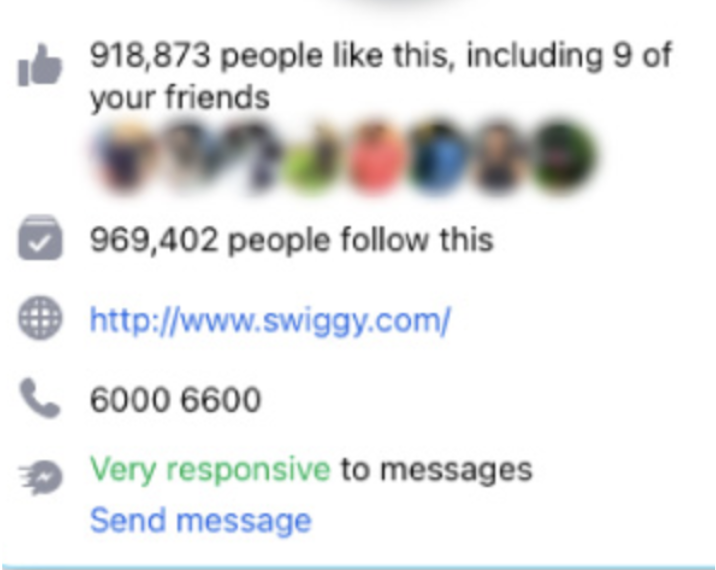
Finding Success with Facebook Ads
Running successful Facebook ad campaigns requires some training in social media marketing. We highly recommend you complete this free course from Facebook before running your first ad. However, given the role ads play in using your Facebook business page for better sales, we have given an overview of the topic below.
Facebook Ad Types
Facebook offers a variety of ad types to cater to different business objectives. These include:
- Image ads use striking visuals to capture attention.
- Video ads use short clips and longer segments to dynamically convey your message.
- Carousel ads showcase up to ten images or videos within a single ad, each with its own link, allowing you to highlight multiple products or aspects of your service.
- Slideshow ads use motion, sound, and text to display your product.
- Collection ads allow users to browse more products or learn about your service directly from their newsfeeds.
- Lead ads make it easy for people to provide their contact information without a lot of typing from mobile.
The Facebook Ads Manager is used to create and manage Facebook ads. You can choose your ad objective, define your audience, and set your budget. It also provides analytics to track your ad performance.
Budgeting and Payment
Facebook lets you choose between a cost-per-click (CPC) or cost-per-impression (CPM) payment model. It charges you based on the number of clicks or impressions(views) your ad receives.
Facebook ads work on a bidding system. The higher you bid, the more people get to see your ad. You can set either a daily or lifetime budget for your ads. Facebook spends the amount you specify. It will not charge you more than your daily limit. If you choose a lifetime budget, it will be divided by the length of your campaign to find the daily limit.
It's essential to start with a clear budget and adjust based on the performance and the analytics data you gather.
Targeting Your Audience
The strength of Facebook Ads lies in its targeting capabilities. You should define your audience based on demographics, interests, behaviors, and more. Detailed targeting options allow you to reach a subset of Facebook users most likely to engage with your ad and purchase your product.
Facebook's Audience Insights tool provides information about your current and potential customers. It offers data on your audience's demographics, interests, and Facebook usage. You can tailor your ads to meet their needs and improve your performance.
Meta Pixel
Meta Pixel is a crucial tool for tracking the effectiveness of your ads. It's a line of code that you place on your website to track conversions from Facebook ads. It tracks site visitors who come to your site from your ads. It can also show relevant ads to new site visitors once they visit a website page and return to Facebook.
For example, consider someone adds items to the shopping cart but leaves without checking out. When they next visit Facebook, they will see an ad reminding them to checkout.
Utilizing Meta Pixel data can help you better understand your audience's behavior and refine your advertising strategies for improved ROI.
Semrush tools that will help you make more Facebook sales
Small business owners have to juggle multiple responsibilities, and social media marketing can be overwhelming initially. In today’s competitive environment, apart from Facebook, you must also build your brand on LinkedIn, Pinterest, Instagram, etc, to reach more customers.
That’s where Semrush Social tools comes in. It is a single centralized app from which you can easily manage your presence across Twitter, Pinterest, Instagram, Facebook, Google Business, and LinkedIn accounts. Just log in to Semrush Social and do the following.
Content calendar
Plan the year with personalized content creation ideas and an interactive calendar for every channel in the Social Poster tool. Create content, manage your approval process, and find the best time to post. You can also share any type of social content on your social profiles.
Customer service
Consolidate all your messages, mentions, and tag alerts from all your channels into one simple inbox in the Social Inbox. Organize it with easy tagging and sorting. Use customizable message templates to respond efficiently, even as you identify and resolve problems early on. The tool ensures you never miss a mention again!
Visual analytics
The tool automatically sends regular reports on your social media and competitors' channels, so you no longer have to hunt for data. Reports containing the number of new followers, post reach, post engagement, and engagement rates are delivered straight to your inbox. Track your KPIs with easy-to-understand data visualization from a single dashboard.
Competitor analysis
You can compare your social media performance against any brand and view all of their social media content in one location! Track all your competitors’ accounts in the Social Tracker to uncover their best tactics even before you launch. Jump on the best trends early. Get a 360-degree view of your brand’s impact and make changes dynamically as you grow.
Managing your Instagram business account (along with other social media channels) has never been easier!
FAQs about using Facebook page for business
Is Facebook business page free?
Yes, creating a Facebook business page is completely free. You can use it to share updates, interact with your audience, and provide information about your products or services. While the page itself is free, investing in Facebook Ads or promoting your posts is optional and comes with various budgeting options to increase your page's visibility to a broader audience.
Should a business have multiple Facebook pages?
Multiple Facebook pages are unnecessary for a regular business, as they increase maintenance effort and confuse customers. They are beneficial only under specific circumstances.
For example, Suppose a company operates in different geographic regions or has multiple brands. In that case, multiple Facebook pages allow it to tailor content strategies that resonate with the unique preferences of each audience segment.
How to get 5000 followers on Facebook for free?
Focus on creating and sharing engaging, high-quality content that resonates with your target audience. Utilize Facebook's various content formats, like live videos, stories, and polls, to maintain a dynamic and interactive page. Respond to comments and messages and build a community around your brand. Consistency in posting and interaction is key to reducing ad expenditure.
How often should you post on a Facebook business page?
A general guideline is to post at least once daily but not more than twice in 24 hours. This maintains engagement without overwhelming followers. Prioritize content quality over quantity, ensuring each post provides value to your audience. Semrush Social Tools guides the best times to post based on when your specific audience engages with your content.
Should you like your own business posts on Facebook?
Not every time. It's generally acceptable to like your own posts occasionally, especially if it's content you're particularly proud of or want to highlight. But don’t overdo it. Liking your own posts can slightly increase their visibility in your followers' news feeds, but engaging authentically is a better strategy for long-term success.
What should you not post on your business Facebook page?
It's important to avoid posting content that could harm your brand's reputation or alienate your audience. Avoid posting offensive, controversial, or polarizing material. Never post false information or engage in negative commentary about competitors. You should also refrain from sharing irrelevant viral content or overly promotional content without offering value.
What are the disadvantages of Facebook for business?
Using Facebook for business requires significant time investment. The platform's ever-changing algorithm and competitive landscape also make it challenging to grow consistently without paid promotion. Additionally, the platform requires proactive management to protect against negative comments that spread quickly and harm your brand's reputation. You can solve most of these challenges with a tool like Semrush Social.
